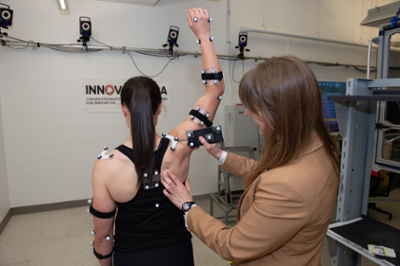Rotator Cuff Injury Study
Exploring the connection between movement patterns and rotator cuff syndrome in high-risk occupations.
Study Description
The goal of this study is to explore the connection between movement patterns and rotator cuff syndrome in high-risk occupations. The long-term aim is to improve the prevention and treatment of rotator cuff syndrome. Participants will come into our lab for an initial testing session, monitored for two years, and may be asked to come back for a follow up session.
What Does the Study Involve?
Time Commitment
The testing session for the study will be approximately 1.5 hours.
After initial testing you will be contacted via email every three months for two years to assess development of shoulder pain or injury.
You may be asked to return to complete another testing session in the event you develop symptoms.
Testing Procedure

- You will be asked to complete some questionnaires about your upper limb use ability, activity level and occupation
- Height, weight, age and handedness will be measured
- Reflective markers and muscle activity sensors (EMG) will be placed on your upper limbs and torso
- You will be asked to complete muscle strength and functional tasks
- All tasks will be demonstrated and explained to you before you preform them
- Rest breaks will be provided
- We ask that you wear a tank top, comfortable pants or shorts, and comfortable shoes for the testing session
For more details about the research, see our published protocol linked here:
Study Follow Ups
You will be contacted every three months for the following two years after your initial testing session. These follow ups will be brief to assess whether you have developed shoulder pain or injury.
Who Can Get Involved?
- You are an adult at least 18 years of age
- Your occupation may be at high risk for shoulder injuries:
- Nurse, Nurse aide, Continuing care aide
- Farm worker/farm aid
- Construction
- Hairstylist
- Maintenance, Caretaking
- You do not currently have shoulder pain (any diagnosis)
- You do not have a history of shoulder pain that resulted in;
- A clinician visit (primary care or physical therapy)
- Stoppage of regular activities (work or sport and leisure) for 1 month or more
- You do not have;
- Upper limb arthritis, history of stroke, history of shoulder surgery (e.g. rotator cuff repair, breast cancer treatment, shoulder replacement), carpal tunnel or pain/discomfort in the cervical region
- You are not currently pregnant
If you have an allergy or sensitivity to adhesives, you should consider also not participating.
If you are interested in learning more or would like to participate, please contact Dr. Kenzie Friesen (kenzie.friesen@usask.ca) or Dr. Angelica Lang (angelica.lang@usask.ca).
